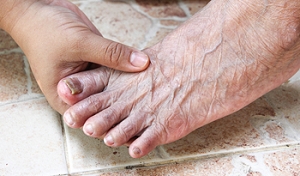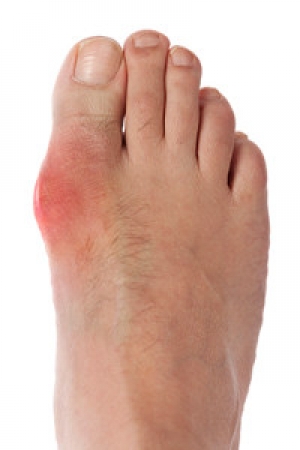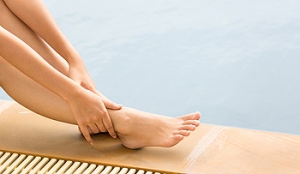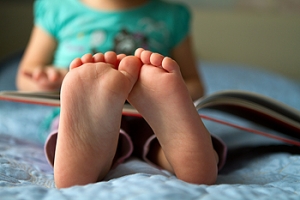
How To Prevent Toenail Fungus
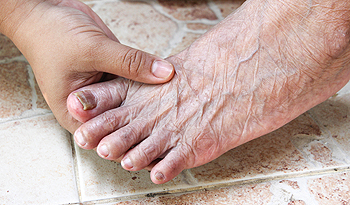 If your toenails become thick and begin turning yellow, chances are you may have a fungal infection. Also referred to as onychomycosis (OM), many people suffer from this, especially those afflicted with other health issues including diabetes or a weakened immune system. This type of fungus grows and lives in moist environments that are warm, typically affecting people whose feet sweat frequently. The infection may occur because of small cuts on the toes or under the nail, thereby allowing the fungi to enter. Prevention of this condition may include drying the feet thoroughly, keeping nails short, and wearing proper footwear in public showers. Please consider a consultation with a podiatrist for optimum treatment options.
If your toenails become thick and begin turning yellow, chances are you may have a fungal infection. Also referred to as onychomycosis (OM), many people suffer from this, especially those afflicted with other health issues including diabetes or a weakened immune system. This type of fungus grows and lives in moist environments that are warm, typically affecting people whose feet sweat frequently. The infection may occur because of small cuts on the toes or under the nail, thereby allowing the fungi to enter. Prevention of this condition may include drying the feet thoroughly, keeping nails short, and wearing proper footwear in public showers. Please consider a consultation with a podiatrist for optimum treatment options.
For more information about treatment, contact one of our podiatrists of James Kutchback, DPM, CWS-P. Our doctors can provide the care you need to keep you pain-free and on your feet.
Toenail Fungus Treatment
Toenail fungus is a condition that affects many people and can be especially hard to get rid of. Fortunately, there are several methods to go about treating and avoiding it.
Antifungals & Deterrence
Oral antifungal medicine has been shown to be effective in many cases. It is important to consult with a podiatrist to determine the proper regiment for you, or potentially explore other options.
Applying foot powder on the feet and shoes helps keep the feet free of moisture and sweat.
Sandals or open toed shoes – Wearing these will allow air movement and help keep feet dry. They also expose your feet to light, which fungus cannot tolerate. Socks with moisture wicking material also help as well.
If you have any questions please contact our offices located in The Woodlands and Woodville, TX . We offer the newest diagnostic and treatment technologies for all your foot and ankle needs.
Toenail Fungus
Toenail fungus is a frustrating problem that affects many people. It can be persistent and hard to get rid of. As many different types of fungi are present throughout the environment, it is very easy to contract toenail fungus.
The feet are especially susceptible to toenail fungus because shoes and socks create the ideal dark and moist environment that fungal infections thrive in. While fungal infections of the nail plate are quite common, if left untreated they can spread beyond the toenail and into the skin and other parts of the body.
Signs of toenail fungus include a thickened nail that has become yellow or brown in color, a foul smell, and debris beneath the nail. The toe may become painful due to the pressure of a thicker nail or the buildup of debris.
Treatment for toenail fungus is most effective during the early stages of an infection. If there is an accumulation of debris beneath the nail plate, an ingrown nail or a more serious infection can occur. While each treatment varies between patients, your podiatrist may prescribe you oral medications, topical liquids and creams, or laser therapy. To determine the best treatment process for you, be sure to visit your podiatrist at the first signs of toenail fungus.
The Causes of Gout
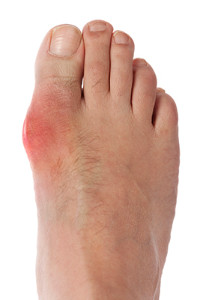 Painful attacks in the joints of the foot, especially the big toe, may be indicative of a condition referred to as gout. When an excess of uric acid builds up in the body, it can typically form into crystals; this can inflame the joints, possibly causing severe pain and swelling. Long-term arthritis is common if the cartilage is damaged due to a build up of crystals. Most sufferers of gout can find relief in lifestyle changes, including a healthy diet and exercise. Lowering the amount of uric acid in the body is an effective way in treating gout and can possibly be achieved by drinking plenty of water and limiting alcohol. Additionally, avoiding red meat and consuming a diet rich in vitamin C may also be helpful in eliminating crystals from the kidneys. If you experience pain in the big toe and foot, a consultation with a podiatrist is advised.
Painful attacks in the joints of the foot, especially the big toe, may be indicative of a condition referred to as gout. When an excess of uric acid builds up in the body, it can typically form into crystals; this can inflame the joints, possibly causing severe pain and swelling. Long-term arthritis is common if the cartilage is damaged due to a build up of crystals. Most sufferers of gout can find relief in lifestyle changes, including a healthy diet and exercise. Lowering the amount of uric acid in the body is an effective way in treating gout and can possibly be achieved by drinking plenty of water and limiting alcohol. Additionally, avoiding red meat and consuming a diet rich in vitamin C may also be helpful in eliminating crystals from the kidneys. If you experience pain in the big toe and foot, a consultation with a podiatrist is advised.
Gout is a foot condition that requires certain treatment and care. If you are seeking treatment, contact one of our podiatrists from James Kutchback, DPM, CWS-P. Our doctors will treat your foot and ankle needs.
What Is Gout?
Gout is a type of arthritis caused by a buildup of uric acid in the bloodstream. It often develops in the foot, especially the big toe area, although it can manifest in other parts of the body as well. Gout can make walking and standing very painful and is especially common in diabetics and the obese.
People typically get gout because of a poor diet. Genetic predisposition is also a factor. The children of parents who have had gout frequently have a chance of developing it themselves.
Gout can easily be identified by redness and inflammation of the big toe and the surrounding areas of the foot. Other symptoms include extreme fatigue, joint pain, and running high fevers. Sometimes corticosteroid drugs can be prescribed to treat gout, but the best way to combat this disease is to get more exercise and eat a better diet.
If you have any questions, please feel free to contact our offices located in The Woodlands and Woodville, TX . We offer the newest diagnostic and treatment technologies for all your foot care needs.
Everything You Need to Know About Gout
Gout, typically found in diabetic patients, is an unusually painful form of arthritis caused by elevated levels of uric acid in the bloodstream. The condition typically strikes the big joint on the big toe. It has also been known to strike the knees, elbows, fingers, ankles and wrists—generally anywhere that has a functioning, moving joint.
The high level of uric acid in a person’s bloodstream creates the condition known as hyperuricema—the main cause of gout. Genetic predisposition occurs in nine out of ten sufferers. The children of parents who suffer gout will have a two in ten chance of developing the condition as well.
This form of arthritis, being particularly painful, is the leftover uric acid crystallizing in the blood stream. The crystallized uric acid then travels to the space between joints where they rub, causing friction when the patient moves. Symptoms include: pain, redness, swelling, and inflammation. Additional side effects may include fatigue and fever, although reports of these effects are very rare. Some patients have reported that pain may intensify when the temperature drops, such as when you sleep.
Most cases of gout are easily diagnosed by a podiatrist’s assessment of the various symptoms. Defined tests can also be performed. A blood test to detect elevated levels of uric acid is often used as well as an x-ray to diagnose visible and chronic gout.
Treatment for gout simply means eliminating symptoms. Non-steroid anti-inflammatory drugs or NSAIDs (Colchicine and other corticosteroid drugs, etc.) will quell the redness, the swelling, and the inflammation. However, managing your diet, lifestyle changes, and using preventative drugs are all helpful toward fully combating the most severe cases.
Those that lead an inactive lifestyle are at a higher risk for gout. Any amount of exercise decreases the probability of repeat encounters with the condition. Reducing your consumption of red meat, sea food, and fructose-sweetened drinks also reduces the likelihood of chronic gout as well.
Ingesting Vitamin C, coffee, and particular dairy products can help with maintaining a healthy lifestyle. There are new drugs out on the market that inhibit the body’s production of uric acid-producing enzymes. However, reducing or eliminating your overall levels of uric acid is the best remedy to ensuring you lead a gout-free life.
Causes of Sensations in Your Feet
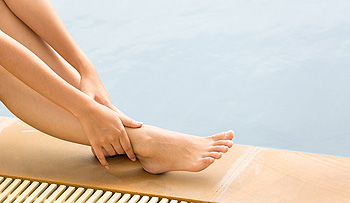 While many people will experience a harmless tingling sensation in their feet at some point in their life, in some cases this may be a sign of a potentially serious underlying condition. Neuropathy, or a loss of sensation that commonly occurs in the extremities due to diabetes, can cause a tingling sensation in the feet or even numbness. A number of infections, such as AIDS, leprosy, Lyme disease, and others, can cause a tingling sensation in the feet. Pregnancy can also cause sensation loss or a "pins and needles" feeling in the feet. The list of potential causes is large, with some including toxin exposure, alcoholism, vitamin deficiency, vasculitis, and others. Due to the wide array of potential causes, it is advised that you see a podiatrist who can properly diagnose the cause and provide treatment.
While many people will experience a harmless tingling sensation in their feet at some point in their life, in some cases this may be a sign of a potentially serious underlying condition. Neuropathy, or a loss of sensation that commonly occurs in the extremities due to diabetes, can cause a tingling sensation in the feet or even numbness. A number of infections, such as AIDS, leprosy, Lyme disease, and others, can cause a tingling sensation in the feet. Pregnancy can also cause sensation loss or a "pins and needles" feeling in the feet. The list of potential causes is large, with some including toxin exposure, alcoholism, vitamin deficiency, vasculitis, and others. Due to the wide array of potential causes, it is advised that you see a podiatrist who can properly diagnose the cause and provide treatment.
Everyday foot care is very important to prevent infection and other foot ailments. If you need your feet checked, contact one of our podiatrists from James Kutchback, DPM, CWS-P. Our doctors can provide the care you need to keep you pain-free and on your feet.
Everyday Foot Care
Often, people take care of their bodies, face and hair more so than they do for their feet. But the feet are a very important aspect of our bodies, and one that we should pay more attention to. Without our feet, we would not be able to perform most daily tasks.
It is best to check your feet regularly to make sure there are no new bruises or cuts that you may not have noticed before. For dry feet, moisturizer can easily be a remedy and can be applied as often as necessary to the affected areas. Wearing shoes that fit well can also help you maintain good foot health, as well as making it easier to walk and do daily activities without the stress or pain of ill-fitting shoes, high heels, or even flip flops. Wearing clean socks with closed shoes is important to ensure that sweat and bacteria do not accumulate within the shoe. Clean socks help to prevent Athlete’s foot, fungi problems, bad odors, and can absorb sweat.
If you have any questions, please feel free to contact our offices located in The Woodlands and Woodville, TX . We offer the newest diagnostic and treatment technologies for all your foot care needs.
Every Day Foot Care
Our feet are important in our everyday lives. The problem is that we tend to neglect them. When this becomes a habit, it can cause significant trouble. Ignoring foot problems can mean pain, limited mobility, and expensive doctor's visits. On the other hand, if feet are cared for and looked after regularly, they will perform without pain or complication.
Routine hygiene is the most basic way to care for the feet. Wash and dry them thoroughly daily. Remember to get between the toes and keep the toenails trimmed and short. If the feet feel dry or there are signs of dryness or cracking, use a moisturizer designed for the feet.
When using moisturizer on the feet, try to avoid applying between the toes. If cream or lotion sits too long, they can cause fungal and bacterial growth. When moisturizer is used between the toes, it can also cause the skin to soften too much.
Shoes are also an important aspect of foot care. When one is picking out shoes, make sure they are the correct size. Shoes need to be snug, but not too tight. On the other hand, if shoes are too loose they can cause foot problems as well. It is highly recommended that shopping for new shoes be done later in the day. The reason for this is that the feet will have settled and swelled to their full size by then. To keep your feet at their most healthy, avoid wearing high heels or flip flops too often. Instead, choose shoes that are good for your feet. Good shoes pad the soles of your feet and support the arches and ankles.
Socks should also be worn daily with closed-toe shoes. They may feel hot during the summer months, but they absorb sweat and moisture off the feet. Without socks, the build-up of sweat in a closed-toe shoe can cause fungal problems and athlete's foot.
The best thing to remember in every day foot care is that shoes do make a difference. If you spend a lot of time on your feet, make sure that your shoes show no signs of wear. Shoes should offer ample support for the arches and the overall foot. Additionally, try to make foot cleaning and maintenance a daily habit. If you keep these things in mind, your feet will stay healthy and safe.
Preventing Athlete’s Foot Among Children
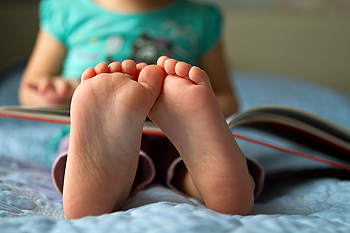 Athlete’s foot is a fungal infection that affects the skin on the foot. While generally not a serious condition, it can be bothersome and is contagious. As a parent, making sure your children maintain proper foot care is an important step in preventing ailments like athlete’s foot. Here are some steps that you should teach your children to help prevent athlete’s foot. Make sure that they wear flip-flops or sandals in public bathrooms and around pools. When they are drying their feet, make sure they dry in between their toes, as athlete’s foot often occurs in this area. Keep your house and their play areas clean. Teach them to not share some items like towels or shoes, as these items may be contaminated already. Finally, check their feet for any symptoms of athlete’s foot such as redness, itchiness, or scaly skin.
Athlete’s foot is a fungal infection that affects the skin on the foot. While generally not a serious condition, it can be bothersome and is contagious. As a parent, making sure your children maintain proper foot care is an important step in preventing ailments like athlete’s foot. Here are some steps that you should teach your children to help prevent athlete’s foot. Make sure that they wear flip-flops or sandals in public bathrooms and around pools. When they are drying their feet, make sure they dry in between their toes, as athlete’s foot often occurs in this area. Keep your house and their play areas clean. Teach them to not share some items like towels or shoes, as these items may be contaminated already. Finally, check their feet for any symptoms of athlete’s foot such as redness, itchiness, or scaly skin.
Athlete’s foot is an inconvenient condition that can be easily reduced with the proper treatment. If you have any concerns about your feet and ankles, contact one of our podiatrists from James Kutchback, DPM, CWS-P. Our doctors will treat your foot and ankle needs.
Athlete’s Foot: The Sole Story
Athlete's foot, also known as tinea pedis, can be an extremely contagious foot infection. It is commonly contracted in public changing areas and bathrooms, dormitory style living quarters, around locker rooms and public swimming pools, or anywhere your feet often come into contact with other people.
Solutions to Combat Athlete’s Foot
- Hydrate your feet by using lotion
- Exfoliate
- Buff off nails
- Use of anti-fungal products
- Examine your feet and visit your doctor if any suspicious blisters or cuts develop
Athlete’s foot can cause many irritating symptoms such as dry and flaking skin, itching, and redness. Some more severe symptoms can include bleeding and cracked skin, intense itching and burning, and even pain when walking. In the worst cases, Athlete’s foot can cause blistering as well. Speak to your podiatrist for a better understanding of the different causes of Athlete’s foot, as well as help in determining which treatment options are best for you.
If you have any questions please feel free to contact our offices located in The Woodlands and Woodville, TX . We offer the newest diagnostic and treatment technologies for all your foot and ankle needs.
Athlete's Foot
Athlete’s foot is an extremely contagious infection caused by a fungus that results in itching, burning, dry, and flaking feet. The fungus that causes athlete’s foot is known as tinea pedis and thrives in moist, dark areas such as shower floors, gyms, socks and shoes, commons areas, public changing areas, bathrooms, dormitory style houses, locker rooms, and public swimming pools. Athlete’s foot is difficult to treat as well because of the highly contagious and recurrent nature of the fungus.
Tinea is the same fungus that causes ringworm, and is spread by direct contact with an infected body part, contaminated clothing, or by touching other objects and body parts that have been exposed to the fungus. Because the feet are an ideal place for tinea to grow and spread, this is the most commonly affected area. It is, however, known to grow in other places. The term athlete’s foot describes tinea that grows strictly on the feet.
The most commonly infected body parts are the hands, groin, and scalp, as well as the feet. Around 70% of the population suffer from tinea infections at some point in their lives, however not all of these cases are athlete’s foot. Just like any other ailment, some people are more likely to get it than others, such as people with a history of tinea infections or other skin infections, both recurring and non-recurring ones. The extent to which a person experiences regrowth and recurrent tinea infections varies from person to person.
Sometimes people will not even know that they are infected with tinea or that they have athlete’s foot because of a lack of symptoms. However, most experience mild to moderate flaking, itching, redness, and burning. However, some of the more severe symptoms include cracking and bleeding skin, intense itching and burning, pain while walking or standing, and even blistering.
Because of the recurring nature of the tinea fungus and the athlete’s foot it causes, the best way to treat this condition is with prevention. You can take some preventative measures such as wearing flip flops or sandals in locker rooms and public showers to reduce contact with the floor. It also helps to keep clean, dry feet while allowing them to breathe. Using powders to keep your feet dry is a good idea, as well as keeping your feet exposed to light and cool air, to prevent the growth of tinea. If you do happen to get athlete’s foot, opt for using topical medicated creams, ointments or sprays. These treatments help eliminate and prevent it from coming back.
Plantar Warts are Caused By A Virus
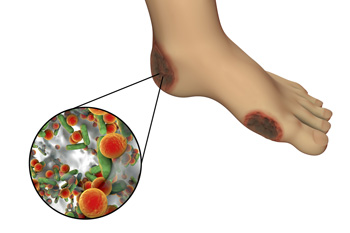 When a wart occurs on the bottom of the foot, it is called a plantar wart. Commonly affecting children and young adults, plantar warts are often extremely painful and can make walking very difficult. Caused by the human papillomavirus, the condition may originate in public showers and can develop from a poor immune system. The virus can enter the skin through small cuts on the sole of the foot but may not become visible for several weeks. Resembling a small cauliflower, a plantar wart often has small black dots in the center, which may be hemorrhages under the skin. By avoiding direct contact with infected surfaces such as public pools and shower floors, contracting the HPV virus may be prevented. Treatment may include salicylic acid, cryotherapy, or surgical removal in severe cases. A consultation with a podiatrist is important for the diagnosis and treatment of plantar warts.
When a wart occurs on the bottom of the foot, it is called a plantar wart. Commonly affecting children and young adults, plantar warts are often extremely painful and can make walking very difficult. Caused by the human papillomavirus, the condition may originate in public showers and can develop from a poor immune system. The virus can enter the skin through small cuts on the sole of the foot but may not become visible for several weeks. Resembling a small cauliflower, a plantar wart often has small black dots in the center, which may be hemorrhages under the skin. By avoiding direct contact with infected surfaces such as public pools and shower floors, contracting the HPV virus may be prevented. Treatment may include salicylic acid, cryotherapy, or surgical removal in severe cases. A consultation with a podiatrist is important for the diagnosis and treatment of plantar warts.
Plantar warts can be very uncomfortable. If you need your feet checked, contact one of our podiatrists from James Kutchback, DPM, CWS-P. Our doctors will assist you with all of your foot and ankle needs.
About Plantar Warts
Plantar warts are the result of HPV, or human papillomavirus, getting into open wounds on the feet. They are mostly found on the heels or balls of the feet.
While plantar warts are generally harmless, those experiencing excessive pain or those suffering from diabetes or a compromised immune system require immediate medical care. Plantar warts are easily diagnosed, usually through scraping off a bit of rough skin or by getting a biopsy.
Symptoms
- Lesions on the bottom of your feet, usually rough and grainy
- Hard or thick callused spots
- Wart seeds, which are small clotted blood vessels that look like little black spots
- Pain, discomfort, or tenderness of your feet when walking or standing
Treatment
- Freezing
- Electric tool removal
- Laser Treatment
- Topical Creams (prescription only)
- Over-the-counter medications
To help prevent developing plantar warts, avoid walking barefoot over abrasive surfaces that can cause cuts or wounds for HPV to get into. Avoiding direct contact with other warts, as well as not picking or rubbing existing warts, can help prevent the further spread of plantar warts. However, if you think you have developed plantar warts, speak to your podiatrist. He or she can diagnose the warts on your feet and recommend the appropriate treatment options.
If you have any questions, please feel free to contact our offices located in The Woodlands and Woodville, TX . We offer the newest diagnostic and treatment technologies for all your foot care needs.




